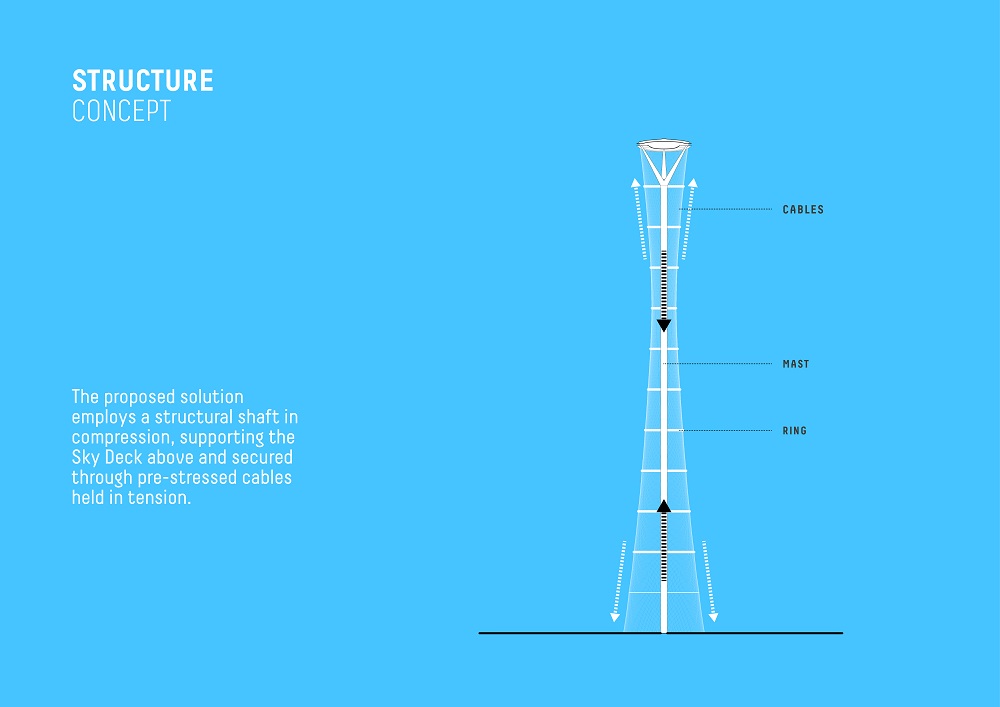The Mile vertical park
At Cannes’ MIPIM real estate fair on March 16th 2016, the design for The Mile will be presented, a one-mile high vertical park and observation deck.
At a proposed height of one mile (1,609 m) it will be the world’s highest man-made construction, around twice the height of Dubai’s Burj Khalifa and taller than the under-construction Jeddah Tower which plans to be around 1 km in height.
The Mile has been developed for an undisclosed client by Carlo Ratti Associati, a design and innovation practice based in Turin, together with German engineering firm schlaich bergermann partner, one of the world’s leading structural engineering offices, and British digital design studio Atmos.
Topped by a publicly-accessible observation deck, from base to apex the structure will offer a natural ecosystem, covered by plants and greenery,inhabited by hundreds of animal species, with a delicate latticework of transportation lines.
The developers believe that the tourist revenue potential of the project is considerable, with the visitor's experience of the Vertical Park both varied and engaging. The ascent to the different observation decks will incorporate orbiting sculptural capsules, which can host meetings, dinners, concerts, or even pools – allowing people to inhabit the sky in many different and exciting ways. The capsules will also be equipped with open-air Virtual Reality screens, for visitors to interact with the 360-degree view.
“Imagine you take New York’s Central Park, turn it vertical, roll it and twirl it”, says Professor Carlo Ratti, founder of the design office CRA and Director of the MIT Senseable City Lab.
To achieve the exceptional height of The Mile, an engineering study was developed to develop a groundbreaking lightweight structure, based on a structural, 20 m-wide shaft, kept in compression and secured through a net of pre-stressed cables. All around the shaft, a series of orbiting capsules will allow visitors to gradually ascend to the top, enjoying the spectacular panorama at different speeds and approaches.
Boris Reyher, Associate and team leader at schlaich bergermann partner said:
“Following the example of the 1972 Munich Olympic complex, engineered by Joerg Schlaich and Rudolf Bergermann, which pushed the boundaries of the possible and became a milestone in architectural history, the structural concept for The Mile is technically feasible because of its consequent and uncompromised light-weight approach.
“The architectural form and the spatial equilibrium of forces become one and the same thing. On the one hand, this leads to an optimised usage of high-grade materials. On the other hand, the structural form and load paths become intuitively comprehensible by every spectator”.
All images courtesy of Carlo Ratti Associati.
You can find out more about The Mile project here.
[edit] Find out more
[edit] Related articles on Designing Buildings Wiki
- 7 Engineering Wonders of the world.
- 9 of the world’s most impressive structures.
- Building of the week series.
- CN Tower.
- Kaplan North Masterplan Complex.
- Megatall.
- New York Horizon.
- Nexus.
- Novotown.
- Shanghai Tower.
- Skyfarm.
- Skyscraper.
- Tallest buildings in the world.
- The history of fabric structures.
- Top 10 skyscrapers located in the UAE.
- Unusual building design of the week.
Featured articles and news
Latest Build UK Building Safety Regime explainer published
Key elements in one short, now updated document.
UKGBC launch the UK Climate Resilience Roadmap
First guidance of its kind on direct climate impacts for the built environment and how it can adapt.
CLC Health, Safety and Wellbeing Strategy 2025
Launched by the Minister for Industry to look at fatalities on site, improving mental health and other issues.
One of the most impressive Victorian architects. Book review.
Common Assessment Standard now with building safety
New CAS update now includes mandatory building safety questions.
RTPI leader to become new CIOB Chief Executive Officer
Dr Victoria Hills MRTPI, FICE to take over after Caroline Gumble’s departure.
Social and affordable housing, a long term plan for delivery
The “Delivering a Decade of Renewal for Social and Affordable Housing” strategy sets out future path.
A change to adoptive architecture
Effects of global weather warming on architectural detailing, material choice and human interaction.
The proposed publicly owned and backed subsidiary of Homes England, to facilitate new homes.
How big is the problem and what can we do to mitigate the effects?
Overheating guidance and tools for building designers
A number of cool guides to help with the heat.
The UK's Modern Industrial Strategy: A 10 year plan
Previous consultation criticism, current key elements and general support with some persisting reservations.
Building Safety Regulator reforms
New roles, new staff and a new fast track service pave the way for a single construction regulator.
Architectural Technologist CPDs and Communications
CIAT CPD… and how you can do it!
Cooling centres and cool spaces
Managing extreme heat in cities by directing the public to places for heat stress relief and water sources.
Winter gardens: A brief history and warm variations
Extending the season with glass in different forms and terms.
Restoring Great Yarmouth's Winter Gardens
Transforming one of the least sustainable constructions imaginable.


























